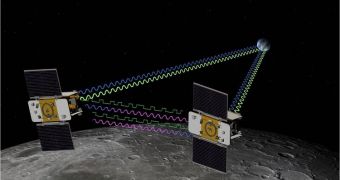Two NASA spacecraft currently on their way to the Moon are getting ready to enter lunar orbit in just a couple of days. The first will carry out this maneuver on December 31, New Year's Eve, while its companion will arrive on January 1, 2012.
The mission, called Gravity Recovery And Interior Laboratory (GRAIL), features two identical spacecraft, A and B, which will enter orbit one day apart, after traveling for more than 3 months after launch. NASA decided to take the scenic route in order to save up on fuel and expand their lifespan.
GRAIL-A is scheduled to achieve orbital insertion at around 1:21 pm PST (2121 GMT) on December 31, whereas GRAIL-B will join in on the fun at around 2:05 pm PST (2205 GMT) on January 1, 2102.
Usually, sending a probe to the Moon takes only about 3 days of travel time, since the spacecraft only has to cover 250,000 miles (402,336 kilometers). But the GRAIL orbiters were set on a course that took 30 times longer, while covering 2.5 million miles (4 million kilometers).
The main benefit of selecting such a path is that the spacecraft can save up on a lot of fuel, therefore extending their mission times after they achieve orbital insertion. The extra fuel will allow them to carry out more maneuvers, and will provide increased flexibility for mission controllers.
Another reason for selecting this flight path is the presence of the Ultra Stable Oscillator (USO) instrument aboard both spacecraft. This is the sole science instrument on the entire mission, and it was preferred that it remained powered throughout the flight.
This allowed USO to achieve its optimal operations temperature long before the probes made their way into lunar orbit. GRAIL's single purpose is to measure the entire gravity field of the Moon, by traveling above its surface in a very tight formation.
USO sends radio beams between GRAIL-A and GRAIL-B, measuring how far they are from each other with extreme precision. Whenever the formation passes over areas of varied gravity, that distance changes nearly imperceptible, and the science instrument picks up those variations.
This allows the science team to transform motion data into a high-resolution map of the Moon's gravity.
“Our team may not get to partake in a traditional New Year's celebration, but I expect seeing our two spacecraft safely in lunar orbit should give us all the excitement and feeling of euphoria anyone in this line of work would ever need,” David Lehman explains.
The NASA official is the GRAIL project manager, at the Jet Propulsion Laboratory (JPL), in Pasadena, California. The Lab manages the two probes for the NASA Science Mission Directorate (SMD), in Washington, DC.

 14 DAY TRIAL //
14 DAY TRIAL //